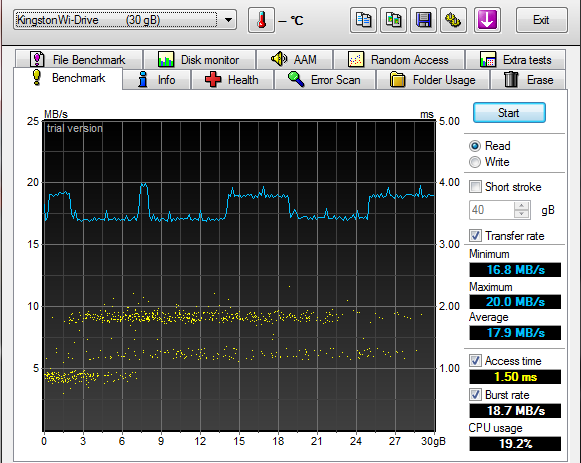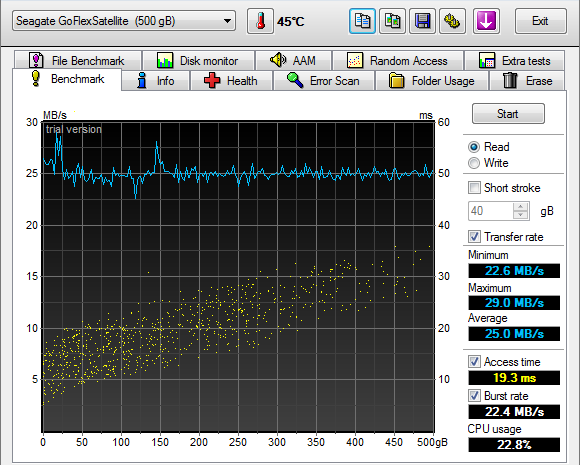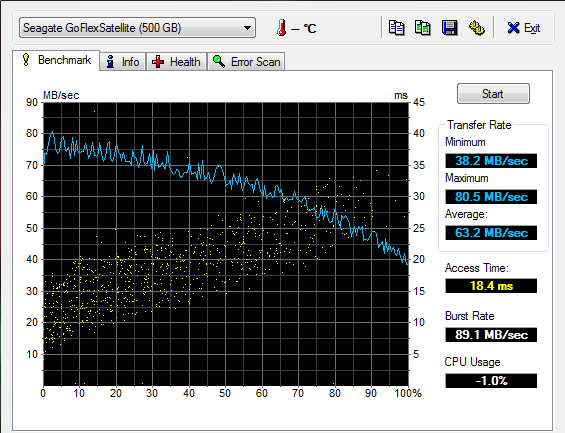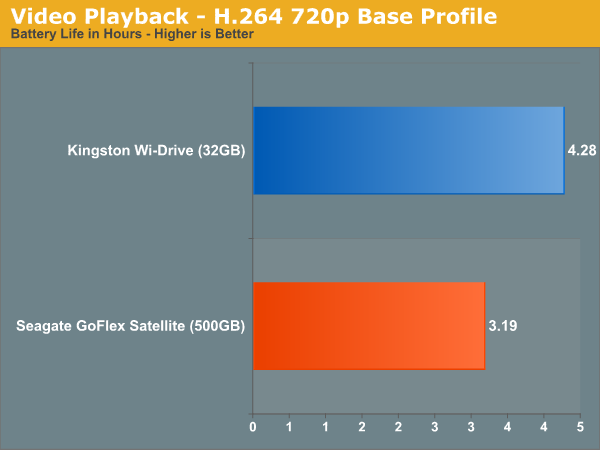Understanding Wireless Storage: Kingston Wi-Drive and Seagate GoFlex Satellite
by Vivek Gowri on November 21, 2011 2:30 PM ESTStorage and Wireless Performance
To test performance, I hooked both drives up to a PC and used HD Tune to get an idea of read performance and access time. The Kingston is USB 2.0 only and ends up performing roughly around the same level as the average USB flash drive. Access times are, as expected, significantly faster than the hard drive-based Seagate, but the NAND here is of the pretty low performance variety. Admittedly, this makes sense—cost and power consumption are far more important than outright speed in this type of application.

The Seagate has a SATA-to-USB 3.0 bridge, so it’s capable of significantly faster I/O speeds than the Wi-Drive. In the HD Tune graph over USB 2.0, we can see it’s basically pegged at the bandwidth limit of the interface (only around 25MB/s in this case, even though USB 2.0 can theoretically hit over 50MB/s). Switch to USB 3.0 and we get transfer rates typical of 5400RPM laptop drives.

GoFlex Satellite, USB 2.0

GoFlex Satellite, USB 3.0
Both drives are more than fast enough to stream high bitrate 720p video over 2.4GHz 802.11g/n, so long as you maintain a decent signal. I found that anything within 10 feet was good enough—I left both in a bag in the overhead bin on a 737 and connected just fine from my iPad at my seat. However, once you lose line of sight and start moving to distances of over 30 feet away from the streamer with a few walls and assorted furniture in between, you'll typically start to see some stuttering in the videos. That’s to be expected though, as it’s an extreme case for wireless range.
Battery Life
Battery life is an interesting topic. Kingston quotes a four hour battery runtime for the Wi-Drive while Seagate claims up to five hours on the Satellite's 10.36Wh battery, but it's not clear what kind of usage those figures represent. I fired up a trusty old loop of The Bourne Identity on each of the streamers playing through my iPad, placed the device two feet in front of the iPad, and unplugged it. I then time how long it is before the video dies, and that’s our winner.

Interestingly, the Kingston actually beat the claimed battery life spec, clocking in at 4:17, while the Seagate gave us pretty disappointing runtime at just under three and a quarter hours. It makes sense that the mechanical hard drive consumes more power, but it’s disappointing that our streaming HD video test undercut the claimed battery figures by that much.










32 Comments
View All Comments
Glibous - Monday, November 21, 2011 - link
I really like how the WD product looks but as you said in the first page...looks like a re-purposed iPhone 3G. It is very similar. I'm just hoping Apple doesn't find a way to use that in another patent war. I don't think WD has the same capital as Samsung to fight them off..Impulses - Monday, November 21, 2011 - link
These things would be irrelevant if Apple included microSD slots and/or USB slots into their devices. 32GB Class 4 cards from Sandisk can easily be found for $35.Almost every Android tablet can be connected to a portable USB HDD or any thumbdrive with a USB OTG cable; or an extra adapter in the case of tablets like the Galaxy 10.1 and TF which lack USB w/o a dock and only have the propietary charging ports on board ($10 adapter converts that to USB). Even some phones can use OTG USB cables to hook up HDDs, gamepads, etc.
Just saying...
Johnmcl7 - Monday, November 21, 2011 - link
This is exactly what I was thinking when reading the article and surprised none of it is mentioned, I can certainly see why these devices may be useful for Apple owners but less so for Android over time. I currently have a Galaxy Note so if I was needing more storage I can either pop in a micro SD card (or have multiple and swap between them) or simply plug in a standard USB flash drive or hard drive through USB OTG.John
melgross - Monday, November 21, 2011 - link
Honestly, most other companies use SD slots so they can cheap out on the memory they offer. Often when buying one, it comes with even less memory than the lowest memory version of the Apple device, forcing you to buy more just to get even.In addition, when you rely not hat, as I did with my Treo 700p, you find that your always changing out cards, because you have different things on each card. With bigger cards these days that's less of an issue, but it still exists. And it's only now that Google is making storage on cards the same as internal storage. Truth is, that's been a bitch.
The only annoying thing about the way Apple does it is to not allow mass storage directly in USB. But then, do you really want external storage dangling off your device? I don't.
The improvement to the Kingston that I would like to see is for it to not have any internal storage, but to have a UDMA 7 CF slot instead.
medi01 - Monday, November 21, 2011 - link
BS.Most other companies do not have loyal fun base that is eager to pay 100$ per 16Gb "extra" memory.
Same goes for your "often" argument. Most Android tablets start with 16Gb AND have micro SD slot.
medi01 - Monday, November 21, 2011 - link
I wish I new which device with micro SD card support has it "dungling out of the device". Maybe ifanboi need to look around.inplainview - Monday, November 21, 2011 - link
What? Could not quite comprehend the insult you were trying to throw. Try again please.inplainview - Monday, November 21, 2011 - link
I know you from AI mate. How's things and your arguments are spot on here as over there.Johnmcl7 - Monday, November 21, 2011 - link
The Note offers either 16GB or 32GB (more than the base Apple devices) and as it supports 64GB (and more beyond) SDXC cards that takes its capacity beyond the largest Apple offer and my last phone was 32GB onboard and microSD expansion. And as SDXC cards expand, it's likely the Note can take more memory than the next Iphone as well. Google is not making internal the same as external, that's up to the handset manufacturers and it's not uniform across Android devices. I don't see your Treo example as relevant as the market has changed substantially in the many years since it was released.As for devices hanging off the devices, if it's sitting docked or similar (which is where I'd be using a storage device) then I wouldn't mind having a cable coming off it just as I have no problem running it with headphones attached.
Plus at worse if I really want to use a wifi storage devices as reviewed here, I still can. However it's not been a problem previously and doubt it will be now
sethiol - Monday, November 21, 2011 - link
Ditto. Just one more reason why I tend to avoid most Apple products.